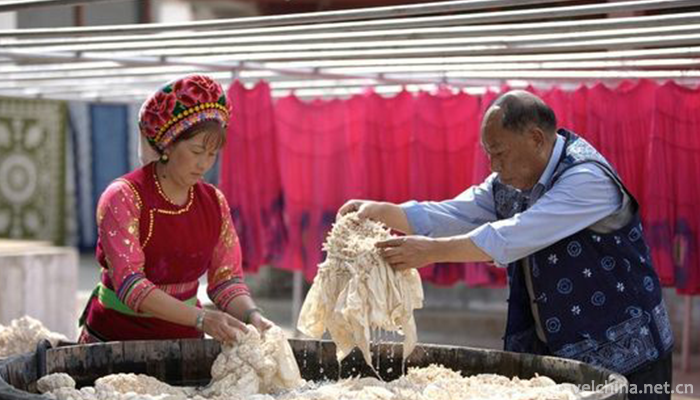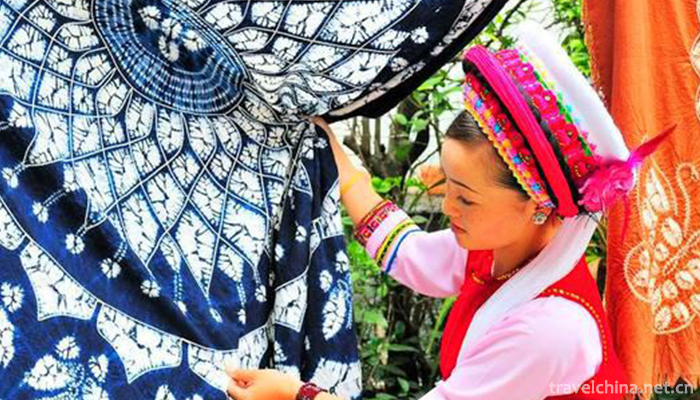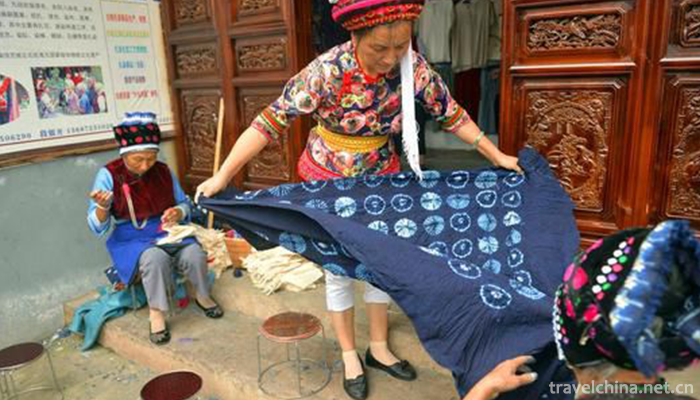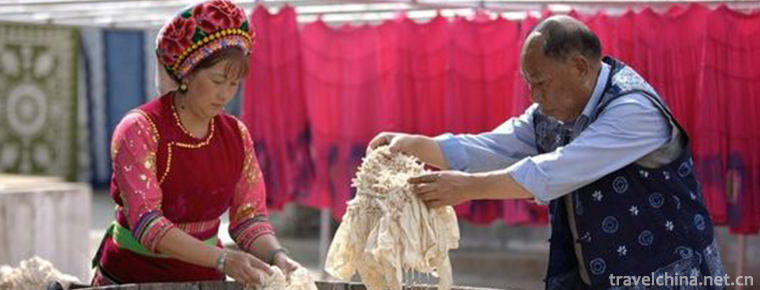Bai nationality tiedyeing skills
Bai nationality tiedyeing skills
Bai tie-dyeing technology, the local traditional textile dyeing technology in Dali City, Yunnan Province, is one of the national intangible cultural heritage.
Tie-dyeing is an ancient textile dyeing technique in China. Tie-dyeing usually takes cotton-white cloth or cotton-linen blended white cloth as raw material, and the dyes are mainly plant indigo (Yunnan folk called Banlangen).
On May 20, 2006, the tie-dyeing skills of the Bai nationality were approved by the State Council and listed in the first batch of national intangible cultural heritage lists.
historical origin
According to historical records, there were dyeing and weaving methods in Dali during the Eastern Han Dynasty.
In the sixteenth year of Tang Zhenyuan, Nanzhao Dance Team came to Chang'an to perform. Its dress was tie-dyed with "skirts of birds, animals, plants and trees, and eight colors of miscellaneous leather".
During the Ming and Qing Dynasties, the dyeing and weaving skills in the Bai nationality area of Erhai Lake reached a high level, and the dyeing and weaving guilds appeared. In the Ming Dynasty, Erhai Weihong cloth, Xizhou cloth and Dali cloth were all well-known and popular products.
Since modern times, Dali dyeing and weaving industry has continued to develop, and Zhoucheng has become a well-known handicraft dyeing village.
Process characteristics
Dali Bai nationality tie-dyeing process is made by manual needle sewing and repeated dyeing with vegetable dyes. The products not only have bright colors and never fade, but also have anti-inflammatory and health-care effects on skin and overcome the side effects of modern chemical dyes harmful to human health.
Based on the combination of pattern art, ancient ligation techniques and modern printing and dyeing techniques, the Bai women in Xizhou, Dali have developed the new hand-printing and dyeing technology of color tie-dyeing. Colour tie-dyeing breaks through the limitations of traditional monochrome tie-dyeing, emphasizing the combination of multi-colour and the unity of colour. Using the difference of width, narrowness, looseness, tightness, sparsity and density when sewing, the depth of dyeing varies and the artistic effect of different patterns is formed.
In some Bai areas, a kind of craftwork called "anti-plain imitation tie-dyeing" is emerging at the historic moment. Anti-plain imitation tie-dyeing is a new technology developed on the basis of ancient tie-dyeing, which is like tie-dyeing rather than tie-dyeing, like splash painting rather than splash painting, and pattern pattern has both tie-dyeing and splash painting styles. Its characteristics are that tie-dyeing process is omitted, pattern and color halo levels are more abundant, showing a mixed, colorful and heavy color effect. Colour tie-dyeing and anti-plain imitation tie-dyeing have the same characteristics and different skills. They can produce hazy flowing style and return to the beauty of nature, better represent the image and add artistic charm.
With the expansion of market demand, Dali tie-dyeing pattern is becoming more and more complex and diversified, at least hundreds of kinds, and all sizes have, derived from tie-dyed bags, tie-dyed hats, tie-dyed skirts and other dazzling handicrafts.
Technological process
The tie-dyeing method is unique. The old books vividly describe the process of tie-dyeing by the ancients: "'Pick up'the tie-dyeing thread, and then dye it." Immediate dyeing, then untie the knot. Every knot has its original colour, while the rest is dyed, and its colour is gorgeous. The main steps of tie-dyeing are brush pattern, stranding, soaking, dyeing cloth, cooking, drying, thread removal, rinsing, and cloth grinding. There are two main processes of tie-dyeing, i.e. tie-up and dip-dyeing. The key technology is the stranding technique and dyeing technique. Dyeing cylinder, dyeing rod, drying rack and stone mill are the main tools for tie-dyeing.
Zha Hua
Tie-up flower, formerly known as knot, is to use wrinkle, fold, roll, squeeze and other methods to make it into a certain shape, then stitch or wrap it with needles and thread one by one, tighten the knot and make the cloth into a series of knots according to the pattern requirements.
The tie-dyeing cloth used to be made entirely of the coarse white cotton cloth hand-woven by the Bai nationality. Because the cloth is less, it is mainly used to weave industrial woven white cloth, packaging cloth and other cloth, which has strong water absorption and soft texture. Folk art designers first draw various patterns according to folk traditions and market needs, together with their own creation. Printers use pricked wax paper to print the designed patterns on raw white cloth. Then the cloth is taken by the women in the village, sewn with meticulous handicraft according to the patterns, and then sent to tie-dyeing factories or dyeing shops.
Tie-up is a hand-made method with sewing as its main part and sewing as its combination. It has the characteristics of wide range of expression, delicate depiction and infinite variation.
Immersion
Immersion dyeing, is about to tie up the "knots" of the cloth first soaked in water, then put into the dyeing vat, or immersion cold dyeing, or heating, boiling hot dyeing, after a certain period of time, pull out drying, and then put the cloth into the dyeing vat dip dyeing. Such repeated dipping, each dipping a deep layer of color, that is, "blue out of blue". The stitched part, because the dyestuff can not be dyed, naturally becomes a beautiful pattern, and because people sew with different stitches, dyeing degree of dyestuff, with a certain degree of randomness, dyed products are rarely identical, its artistic meaning is more.
After dyeing to a certain extent, finally remove the excess dyes and remove the valerian knot after drying, remove the knot, open the knot, ironing smoothly, part of the thread tied and stitched is finally colored, showing a hollow white cloth color, that is, the "flower"; the rest of the dark blue, that is, the "ground", there will be a blue-based white flower pattern, so far, a beautiful tie-dyeing. The cloth is finished. Between "flower" and "ground" there is often a transitional effect of gradual change, many ice cracks, natural, lively, overcome the stiffness of the pictures and patterns, making the colors more rich and natural.
The process of dipping and dyeing is repeated by hand, forming a multi-level halo with flower shape as the center, changeable and mysterious, dignified and elegant, simple and elegant.
Inheritance and protection
Inheritance significance
Dali Bai tie-dyeing shows a strong folk art style. More than 1000 patterns are the epitome of Bai's history and culture for thousands of years. They reflect Bai's folk customs and aesthetic tastes, and form a charming Dali Bai's weaving and dyeing culture with various technological means.
Inheriting characters
Zhang Shishen, male, was born on August 22, 1941. In June 2007, Zhang Shishen was selected as the representative successor of the first batch of national intangible cultural heritage projects, declared by Dali City, Yunnan Province. Project name: Bai tie-dyeing skills.
Duan Yinkai, female, born in 1975. In May 2018, Duan Yinkai was selected as the representative successor of the fifth batch of national intangible cultural heritage projects, declared by Dali City, Yunnan Province. Project name: Bai tie-dyeing skills.
protective measures
In 2012, Duan Yinkai, the national representative inheritor of Bai Puzhen tie-dyeing technology, raised nearly 4 million yuan to build a tie-dyeing Museum in the basic architectural form of "Three Squares, One Wall" and "Four in Five Courtyards", collecting and collating more than 1 800 lost tie-dyeing traditional drawings, 3 600 templates and 700 traditional tie-dyeing products.
social influence
international repercussions
From September 6 to 14, 2016, at the intersection of Broadway Avenue and 44th Street in New York, ABC TV, Times Square, New York, at the crossroads of the world, broadcast a 15-second propaganda film of the China Women's Development Foundation's public welfare project on a giant screen, representing the Bai tie-dyeing skills made by Zhang Zhaoda and his "mother" Bai and Yi mothers, with pure plant dyes. The handmade tie-dyed scarf, a public welfare product with Oriental symbols created by the famous artist, was displayed in the promotional film.
Important activities
From April 6 to April 10, 2013, the 4th Western Intangible Cultural Heritage Exhibition Series, co-sponsored by the Ministry of Culture and the Shaanxi Provincial People's Government, was held in Datangxi City, Xi'an, Shaanxi Province. The tie-dyeing skills of the Bai nationality in Yunnan were displayed in the way of inheritors'on-the-spot skills demonstration and the combination of real objects, pictures and texts.





-
1.Longting Hotel East China Sea Shenzhen
Langting's history can be traced back to 1865. The grand opening of Langting Hotel in central London, England, has become the first truly "luxury hotel" in European history, creating a brill
Time 2018-12-16 -
2.Bayi Memorial Hall in Nanchang
The Bayiyi Memorial Hall in Nanchang was established in 1956 and officially opened to the outside world on October 1, 1959. In 1961, it was announced by the State Council as the first batch of key nat
Time 2018-12-31 -
3.Gongchangling Hot Spring Skiing Ground
Gongchangling Skiing Ground is located in Tanghe Scenic Area of Gongchangling, Liaoyang City, Liaoning Province. It covers an area of 100 hectares and is a national AAA-class tourist attraction.
Time 2019-01-12 -
4.Jinan International Park Expo
Jinan International Park Expo Park covers an area of 5176 Mu and is located in Jinan University Science Park. The Lake area is 1440 mu. It is the largest land park in China
Time 2019-01-21 -
5.Puning Temple
Puning Temple is located in Chengde City, Hebei Province. It was built in the Qianlong period of the Qing Dynasty. The first half of the temple is Han-style,
Time 2019-02-07 -
6.Wheat straw cut and paste
Straw clipping is a traditional folk handicraft. Also known as "wheat straw clipping", "wheat straw clipping". Using the natural luster of wheat straw and the characteristics of ru
Time 2019-05-16 -
7.Munaozaiwa
In May 2011, Munaozaiwa declared by Dehong Dai Jingpo Autonomous Prefecture of Yunnan Province was listed in the third batch of national intangible cultural heritage list with the approval of the Stat
Time 2019-06-06 -
8.Sichuan University Of Science and engineering
Sichuan University of Light Chemical Industry is a general full-time university with more than 50 years of undergraduate and nearly 20 years of postgraduate education, which has coordinated developmen
Time 2019-08-31 -
9.Beijing Film Academy
Beijing Film Academy is a University of art with film history and profound film culture. Its predecessor is the Institute of Performing Arts founded in 1950. It was relocated in 1951 and renamed as th
Time 2019-09-06 -
10.Laojunshan scenic spot in Pingshan County
Laojunshan scenic spot in Pingshan County is a provincial scenic spot approved by the people's Government of Sichuan Province. It is located on the southern edge of Sichuan Basin and is located on the arc-shaped tourism line of Chengdu Emei
Time 2020-10-16 -
11.Mianyang secondary industry
In 2019, the added value of industries above Designated Size in Mianyang will increase by 10.0%, 2.0 percentage points higher than the provincial average level, and the production and sales rate of Industrial Enterprises above designated scale
Time 2020-12-14 -
12.Dazhou Education
In 2019, there are 1455 schools of all kinds in Dazhou. Among them, there are 283 primary schools, 397 ordinary middle schools, 2 ordinary colleges and universities, 33 secondary vocational education schools and 1 adult higher school. There are
Time 2020-12-20